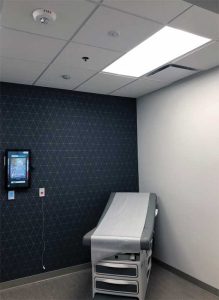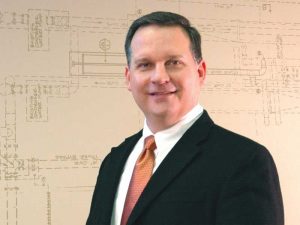
Photo courtesy Rockfon
How ceilings specification impacts operations and maintenance
The healthcare sector is in a constant state of change and improvement. Specifications for hospitals and healthcare facilities face several challenges.
Materials need to be durable over longer periods to maintain visual continuity. Specify products that maintain their appearance, and allow designers to mix and match new and existing ceiling solutions.
Under constant harsh cleaning, ceiling panels must be able to retain their functionality. Specify ceiling surfaces that are easy to vacuum and clean with a damp cloth. For certain areas, specify surfaces that can hold up under more rigorous cleaning procedures.
Ceilings require access to services above, particularly in corridors. Specify ceiling panels that install quickly, are easily demountable, and offer dimensional stability.
Reducing microbes, increasing mold control
To deal with mold, reduce moisture. As a report by U.S. Environmental Protection Agency (EPA) notes: “Since mold requires water to grow, it is important to prevent moisture problems in buildings. Moisture problems can have many causes, including uncontrolled humidity. Some moisture problems in buildings have been linked to changes in building construction practices during the 1970s, ’80s, and ’90s. Some of these changes have resulted in buildings that are tightly sealed but may lack adequate ventilation, potentially leading to moisture buildup.”
The report continues: “Building materials, such as drywall, may not allow moisture to escape easily. Moisture problems may include roof leaks, landscaping or gutters that direct water into or under the building, and unvented combustion appliances. …Delayed maintenance or insufficient maintenance are also associated with moisture problems in schools and large buildings.”
The World Health Organization’s (WHO’s) Guidelines on Indoor Air Quality: Dampness and Mould states:
Microbial pollution is a key element of indoor air pollution. It is caused by hundreds of species of bacteria and fungi, in particular, filamentous fungi (mould), growing indoors when sufficient moisture is available. …The most important means for avoiding adverse health effects is the prevention (or minimization) of persistent dampness and microbial growth on interior surfaces and in building structures.
To help prevent moisture problems, it is important to specify ceiling materials that will not absorb moisture and are not organic such as stone wool and metal; therefore, they do not promote the growth of mold or bacteria. Through their inherent material makeup, there will be no need to incorporate fungicides or antimicrobials to achieve these mold-resistant properties. Prevention of mold and moisture problems also increases the material’s life cycle, cutting down on the need to replace curled and degraded panels.
Recycled content
When the project program or building standards call for materials with recycled content, the ceiling systems can help support that goal. For instance, some metal suspension systems contain up to 90 percent recycled content. Also look for the recyclability of the material, with the goal of being 100 percent recyclable at the end of the useful life cycle.
The panels themselves also can help support recycled goals. Stone wool ceiling panels for example can contain up to 43 percent recycled materials, with its primary source being abundantly available basalt rock.
Conclusion
Never in recent memory have healthcare facilities been so vital to a safe and functioning society. These spaces should be designed, built, and renovated to aid the healing of the most vulnerable. The specification of ceiling systems plays a big role in creating healing environments. Attributes of high-performing ceiling systems include improved acoustic quality, cleanability, high natural light reflectance, ease of maintenance, durability, contributions to good IAQ, as well as sustainability.





